redis分布式锁
目的:解决多个服务原子性的问题
在很多场景中,我们为了保证数据的最终一致性,需要很多的技术方案来支持,比如分布式事务、分布式锁等。那具体什么是分布式锁,分布式锁应用在哪些业务场景、如何来实现分布式锁呢?
锁的种类
- 单机版同一个jvm虚拟机内,synchronized或者Lock接口
- 分布式多个不同虚拟机,单机的线程锁机制不再起作用,资源类在不同的服务器之间共享了
一个靠谱分布式锁需要具备的条件和刚需
独占性
OnlyOne,任何时刻只能有且仅有一个线程持有
高可用
若redis集群环境下,不能因为某一个节点挂了而出现获取锁和释放锁失败的情况
高并发请求下,依旧性能ok好使
防死锁
杜绝死锁,必须有超时控制机制或者撤销操作,有个兜底终止跳出方案
不乱抢
不能私下unlock(解)别人的锁,只能自己加锁自己释放
重入性
同一个节点的同一个线程如何获得锁之后,它也可以再次获得这个锁。
分布式锁
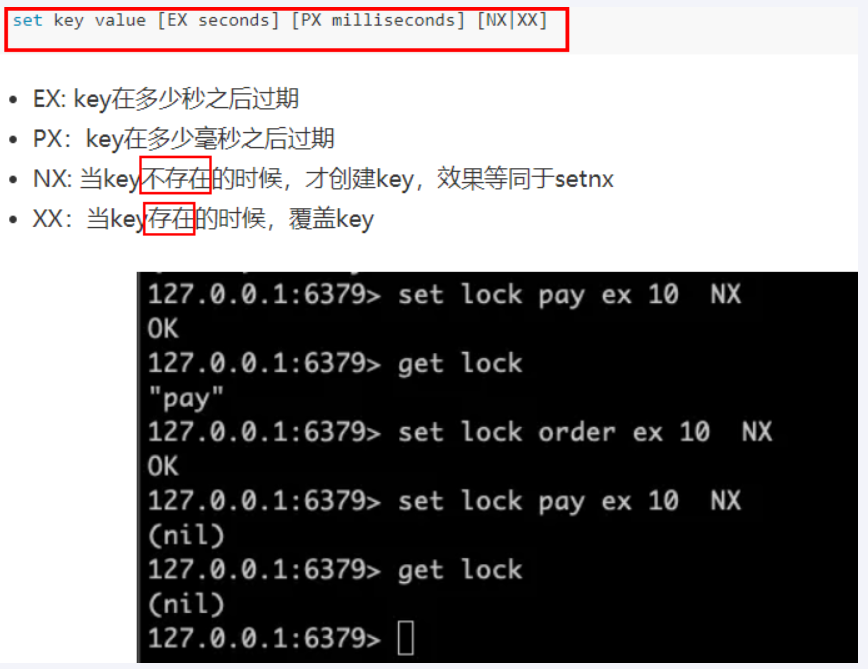
案例1
使用场景:多个服务间保证同一时刻同一时间段内同一用户只能有一个请求(防止关键业务出现并发攻击)
两个服务,分别是redis_distributed_lock2和redis_distributed_lock3代码一样端口号不一样
pom
<!--SpringBoot通用依赖模块-->
<dependency>
<groupId>org.springframework.boot</groupId>
<artifactId>spring-boot-starter-web</artifactId>
</dependency>
<!--SpringBoot与Redis整合依赖-->
<dependency>
<groupId>org.springframework.boot</groupId>
<artifactId>spring-boot-starter-data-redis</artifactId>
</dependency>
<dependency>
<groupId>org.apache.commons</groupId>
<artifactId>commons-pool2</artifactId>
</dependency>
<!--通用基础配置boottest/lombok/hutool-->
<dependency>
<groupId>org.springframework.boot</groupId>
<artifactId>spring-boot-starter-test</artifactId>
<scope>test</scope>
</dependency>
<dependency>
<groupId>org.projectlombok</groupId>
<artifactId>lombok</artifactId>
<version>1.18.36</version>
<optional>true</optional>
</dependency>
<dependency>
<groupId>cn.hutool</groupId>
<artifactId>hutool-all</artifactId>
<version>5.8.8</version>
</dependency>yaml
server:
port: 7777
spring:
application:
name: redis_distributed_lock2
data:
redis:
host: 192.168.0.134
port: 6379
password: redis
lettuce:
pool:
max-idle: 8
max-wait: -1ms
max-active: 8
min-idle: 0
database: 0config
package com.lazy.config;
import org.springframework.context.annotation.Bean;
import org.springframework.context.annotation.Configuration;
import org.springframework.data.redis.connection.lettuce.LettuceConnectionFactory;
import org.springframework.data.redis.core.RedisTemplate;
import org.springframework.data.redis.serializer.GenericJackson2JsonRedisSerializer;
import org.springframework.data.redis.serializer.StringRedisSerializer;
@Configuration
public class RedisConfig {
@Bean
public RedisTemplate<String, Object> redisTemplate(LettuceConnectionFactory lettuceConnectionFactory) {
RedisTemplate<String, Object> redisTemplate = new RedisTemplate<>();
redisTemplate.setConnectionFactory(lettuceConnectionFactory);
//设置key的序列化方式string
redisTemplate.setKeySerializer(new StringRedisSerializer());
//设置value序列化方式json
redisTemplate.setValueSerializer(new GenericJackson2JsonRedisSerializer());
redisTemplate.setHashKeySerializer(new StringRedisSerializer());
redisTemplate.setHashValueSerializer(new GenericJackson2JsonRedisSerializer());
redisTemplate.afterPropertiesSet();
return redisTemplate;
}
}service
package com.lazy.service;
import jakarta.annotation.Resource;
import org.springframework.beans.factory.annotation.Value;
import org.springframework.data.redis.core.StringRedisTemplate;
import org.springframework.stereotype.Service;
import java.util.concurrent.locks.Lock;
import java.util.concurrent.locks.ReentrantLock;
@Service
public class InventoryService {
@Resource
private StringRedisTemplate stringRedisTemplate;
@Value("${server.port}")
private String port;
private final Lock lock = new ReentrantLock();
public String sale()
{
String retMessage = "";
lock.lock();
try
{
//1 查询库存信息
String result = stringRedisTemplate.opsForValue().get("inventory001");
//2 判断库存是否足够
Integer inventoryNumber = result == null ? 0 : Integer.parseInt(result);
//3 扣减库存
if(inventoryNumber > 0) {
stringRedisTemplate.opsForValue().set("inventory001",String.valueOf(--inventoryNumber));
retMessage = "成功卖出一个商品,库存剩余: "+inventoryNumber;
System.out.println(retMessage);
}else{
retMessage = "商品卖完了,o(╥﹏╥)o";
}
}finally {
lock.unlock();
}
return retMessage+"\t"+"服务端口号:"+port;
}
}controller
package com.lazy.controller;
import com.lazy.service.InventoryService;
import jakarta.annotation.Resource;
import org.springframework.web.bind.annotation.GetMapping;
import org.springframework.web.bind.annotation.RestController;
@RestController
public class InventoryController {
@Resource
private InventoryService inventoryService;
@GetMapping("/inventory/sale")
public String sale() {
return inventoryService.sale();
}
}nginx配置
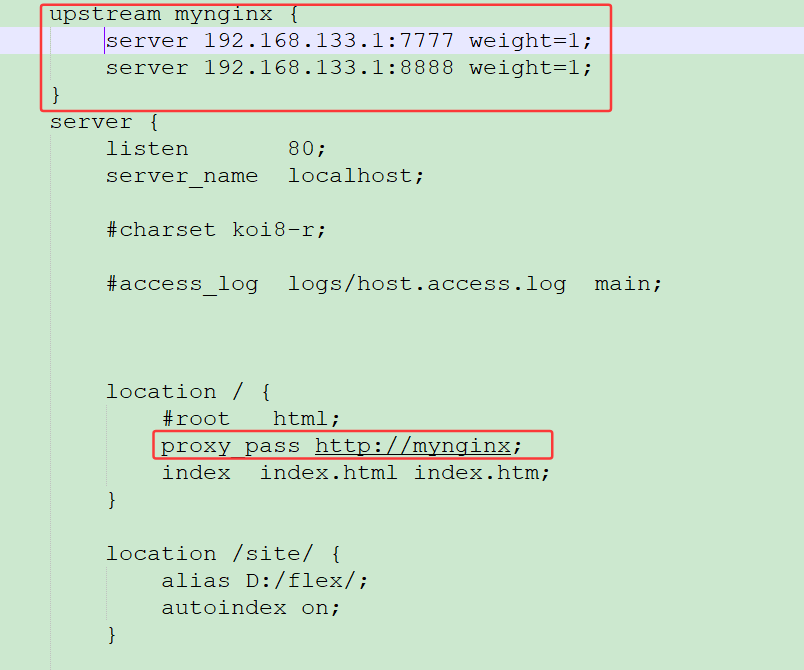
使用start nginx启动即可
测试:
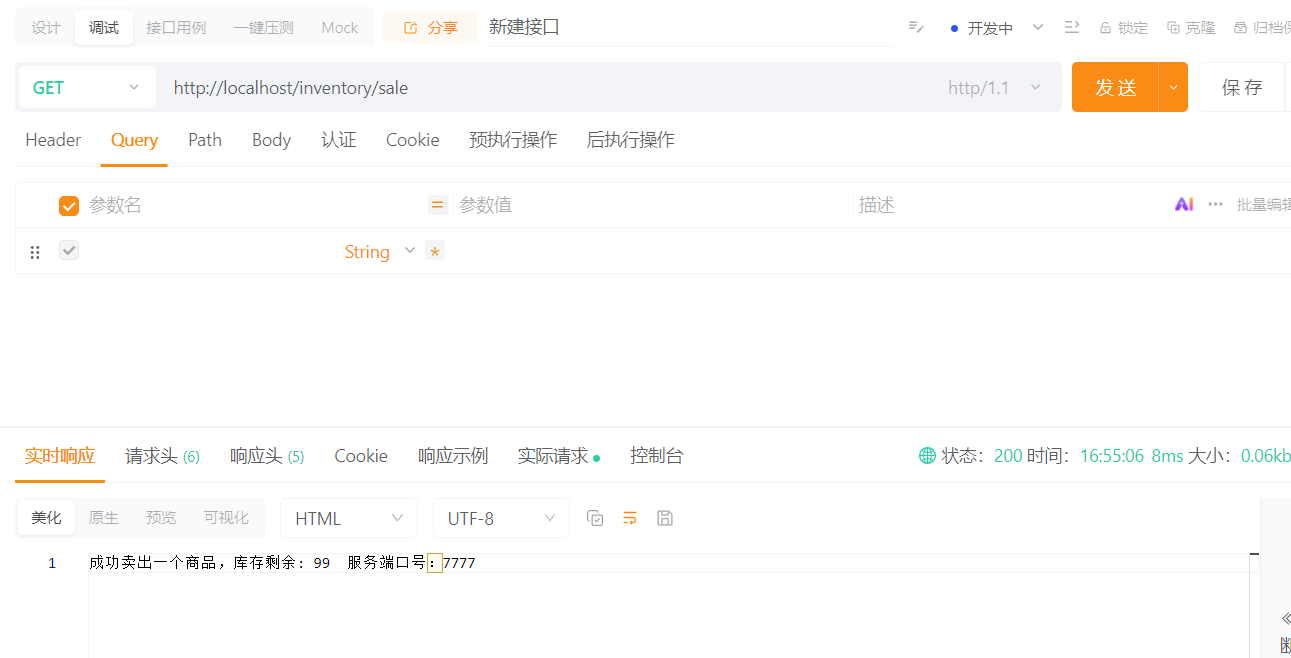
没问题!使用压测工具同时开启100个线程访问


加了lock还是出现超卖的现象,在分布式下毫无意义,因为lock只适用于单服务!
第一次改造(递归重试)
接下来改造我们的service
package com.lazy.service;
import cn.hutool.core.util.IdUtil;
import jakarta.annotation.Resource;
import org.springframework.beans.factory.annotation.Value;
import org.springframework.data.redis.core.StringRedisTemplate;
import org.springframework.stereotype.Service;
import java.util.concurrent.TimeUnit;
@Service
public class InventoryService {
@Resource
private StringRedisTemplate stringRedisTemplate;
@Value("${server.port}")
private String port;
public String sale() {
String retMessage = "";
String key = "lock";
String value = IdUtil.simpleUUID()+":"+Thread.currentThread().getId();//uuid+当前线程id
Boolean flag = stringRedisTemplate.opsForValue().setIfAbsent(key, value);
//判断是否获得锁
if (Boolean.FALSE.equals(flag)){
//未获得锁,停留20毫秒继续抢
try {
TimeUnit.MILLISECONDS.sleep(20);
} catch (InterruptedException e) {
throw new RuntimeException(e);
}
this.sale();
}else{
//获得锁
try {
//1 查询库存信息
String result = stringRedisTemplate.opsForValue().get("inventory001");
//2 判断库存是否足够
Integer inventoryNumber = result == null ? 0 : Integer.parseInt(result);
//3 扣减库存
if (inventoryNumber > 0) {
stringRedisTemplate.opsForValue().set("inventory001", String.valueOf(--inventoryNumber));
retMessage = "成功卖出一个商品,库存剩余: " + inventoryNumber;
System.out.println(retMessage);
} else {
retMessage = "商品卖完了,o(╥﹏╥)o";
}
} finally {
//删除锁
stringRedisTemplate.delete(key);
}
}
return retMessage + "\t" + "服务端口号:" + port;
}
}启动测试,我们要把值修改为5000,我们要使用1秒2w线程数进行压测



这是我们的锁

递归是一种思想没错,但是容易导致StackOverflowError,不太推荐,需要进一步完善,另外,高并发唤醒后推荐用white判断而不是if
第二次改造(while替代)
继续改造service
package com.lazy.service;
import cn.hutool.core.util.IdUtil;
import jakarta.annotation.Resource;
import org.springframework.beans.factory.annotation.Value;
import org.springframework.data.redis.core.StringRedisTemplate;
import org.springframework.stereotype.Service;
import java.util.concurrent.TimeUnit;
@Service
public class InventoryService {
@Resource
private StringRedisTemplate stringRedisTemplate;
@Value("${server.port}")
private String port;
public String sale() {
String retMessage = "";
String key = "lock";
String value = IdUtil.simpleUUID()+":"+Thread.currentThread().getId();//uuid+当前线程id
while (Boolean.FALSE.equals(stringRedisTemplate.opsForValue().setIfAbsent(key, value))) {
//休眠20毫秒
try {
TimeUnit.MILLISECONDS.sleep(20);
} catch (InterruptedException e) {
throw new RuntimeException(e);
}
}
//获得锁
try {
//1 查询库存信息
String result = stringRedisTemplate.opsForValue().get("inventory001");
//2 判断库存是否足够
Integer inventoryNumber = result == null ? 0 : Integer.parseInt(result);
//3 扣减库存
if (inventoryNumber > 0) {
stringRedisTemplate.opsForValue().set("inventory001", String.valueOf(--inventoryNumber));
retMessage = "成功卖出一个商品,库存剩余: " + inventoryNumber;
System.out.println(retMessage);
} else {
retMessage = "商品卖完了,o(╥﹏╥)o";
}
} finally {
//删除锁
stringRedisTemplate.delete(key);
}
return retMessage + "\t" + "服务端口号:" + port;
}
}继续进行压测,压测1轮3000



问题:
- 部署了微服务的java程序机器挂了,代码层面根本没有走到finally这块,没办法保证解锁(无过期时间改key一直存在),这个key没有被删除,需要加入一个过期时间限定key
第三次改造(宕机与过期+防止死锁)
设置key的过期时间,设置过期时间为30秒
package com.lazy.service;
import cn.hutool.core.util.IdUtil;
import jakarta.annotation.Resource;
import org.springframework.beans.factory.annotation.Value;
import org.springframework.data.redis.core.StringRedisTemplate;
import org.springframework.stereotype.Service;
import java.util.concurrent.TimeUnit;
@Service
public class InventoryService {
@Resource
private StringRedisTemplate stringRedisTemplate;
@Value("${server.port}")
private String port;
public String sale() {
String retMessage = "";
String key = "lock";
String value = IdUtil.simpleUUID()+":"+Thread.currentThread().getId();//uuid+当前线程id
while (Boolean.FALSE.equals(stringRedisTemplate.opsForValue().setIfAbsent(key, value,30L, TimeUnit.SECONDS))) {
//休眠20毫秒
try {
TimeUnit.MILLISECONDS.sleep(20);
} catch (InterruptedException e) {
throw new RuntimeException(e);
}
}
//获得锁
try {
//1 查询库存信息
String result = stringRedisTemplate.opsForValue().get("inventory001");
//2 判断库存是否足够
Integer inventoryNumber = result == null ? 0 : Integer.parseInt(result);
//3 扣减库存
if (inventoryNumber > 0) {
stringRedisTemplate.opsForValue().set("inventory001", String.valueOf(--inventoryNumber));
retMessage = "成功卖出一个商品,库存剩余: " + inventoryNumber;
System.out.println(retMessage);
} else {
retMessage = "商品卖完了,o(╥﹏╥)o";
}
} finally {
//删除锁
stringRedisTemplate.delete(key);
}
return retMessage + "\t" + "服务端口号:" + port;
}
}在进行压测

结论:
- 加锁和过期时间必须设置同一行,保证原子性
第四次改造(防止误删key的问题)
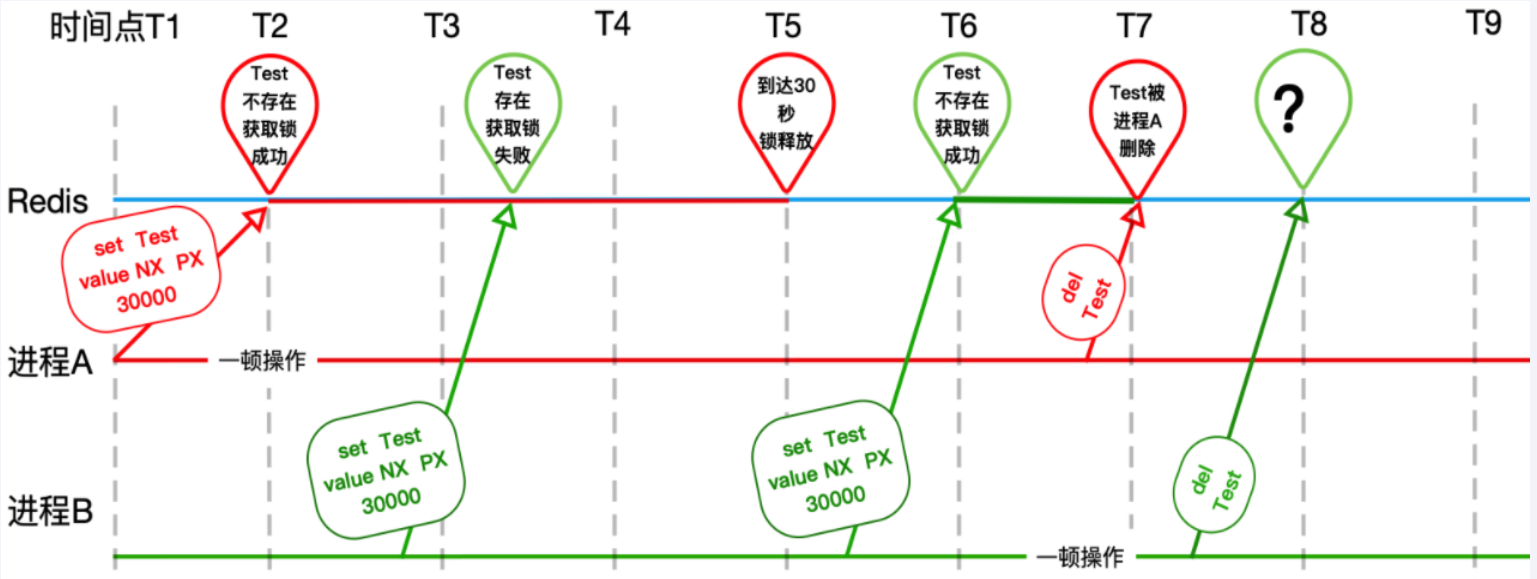
只能删除自己的,不许删除别人的锁
package com.lazy.service;
import cn.hutool.core.util.IdUtil;
import jakarta.annotation.Resource;
import org.springframework.beans.factory.annotation.Value;
import org.springframework.data.redis.core.StringRedisTemplate;
import org.springframework.stereotype.Service;
import java.util.Objects;
import java.util.concurrent.TimeUnit;
@Service
public class InventoryService {
@Resource
private StringRedisTemplate stringRedisTemplate;
@Value("${server.port}")
private String port;
public String sale() {
String retMessage = "";
String key = "lock";
String value = IdUtil.simpleUUID()+":"+Thread.currentThread().getId();//uuid+当前线程id
while (Boolean.FALSE.equals(stringRedisTemplate.opsForValue().setIfAbsent(key, value,30L, TimeUnit.SECONDS))) {
//休眠20毫秒
try {
TimeUnit.MILLISECONDS.sleep(20);
} catch (InterruptedException e) {
throw new RuntimeException(e);
}
}
//获得锁
try {
//1 查询库存信息
String result = stringRedisTemplate.opsForValue().get("inventory001");
//2 判断库存是否足够
Integer inventoryNumber = result == null ? 0 : Integer.parseInt(result);
//3 扣减库存
if (inventoryNumber > 0) {
stringRedisTemplate.opsForValue().set("inventory001", String.valueOf(--inventoryNumber));
retMessage = "成功卖出一个商品,库存剩余: " + inventoryNumber;
System.out.println(retMessage);
} else {
retMessage = "商品卖完了,o(╥﹏╥)o";
}
} finally {
//判断不为空,才能进行equals判断
if (Objects.requireNonNull(stringRedisTemplate.opsForValue().get(key)).equalsIgnoreCase(value)) {
//删除锁
stringRedisTemplate.delete(key);
}
}
return retMessage + "\t" + "服务端口号:" + port;
}
}存在问题,最后判断和删除不是原子性操作,需要使用lua脚本确保一致性操作
第五次改造(保证原子性,使用lua脚本)
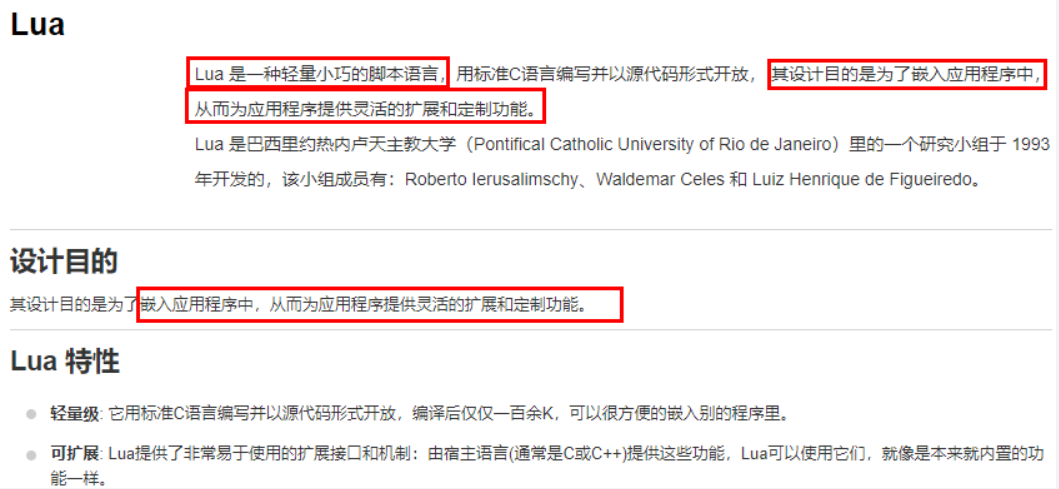
Lua脚本
redis调用Lua脚本通过eval命令保证代码执行的原子性,直接用return返回脚本执行后的结果值
eval命令
EVAL script numkeys key [key ...] arg [arg ...]
#numkeys 代表参数个数
#key 是键
#arg 是具体key的值hello world入门
hello lua
cmd127.0.0.1:6379> EVAL "return 'hello lua'" 0 "hello lua"set k1 v1 get k1
cmd127.0.0.1:6379> EVAL "redis.call('set','k1','v1') return redis.call('get','k1')" 0 "v1"mset
cmd127.0.0.1:6379> EVAL "return redis.call('mset',KEYS[1],ARGV[1],KEYS[2],ARGV[2]) " 2 k1 k2 v1 v2 OK 127.0.0.1:6379> get k1 "v1" 127.0.0.1:6379> get k2 "v2"
Lua脚本进一步
条件判断语法
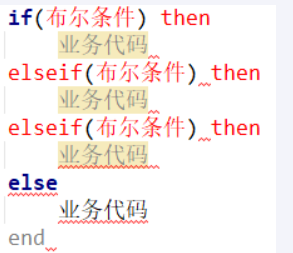
条件判断案例
cmd127.0.0.1:6379> get keys "1" 127.0.0.1:6379> EVAL "if redis.call('get',KEYS[1])==ARGV[1] then return redis.call('del',KEYS[1]) else return 0 end" 1 keys 2 (integer) 0 127.0.0.1:6379> EVAL "if redis.call('get',KEYS[1])==ARGV[1] then return redis.call('del',KEYS[1]) else return 0 end" 1 keys 1 (integer) 1
改造
package com.lazy.service;
import cn.hutool.core.util.IdUtil;
import jakarta.annotation.Resource;
import org.springframework.beans.factory.annotation.Value;
import org.springframework.data.redis.core.StringRedisTemplate;
import org.springframework.data.redis.core.script.DefaultRedisScript;
import org.springframework.stereotype.Service;
import java.util.List;
import java.util.concurrent.TimeUnit;
@Service
public class InventoryService {
@Resource
private StringRedisTemplate stringRedisTemplate;
@Value("${server.port}")
private String port;
public String sale() {
String retMessage = "";
String key = "lock";
String value = IdUtil.simpleUUID()+":"+Thread.currentThread().getId();//uuid+当前线程id
while (Boolean.FALSE.equals(stringRedisTemplate.opsForValue().setIfAbsent(key, value,30L, TimeUnit.SECONDS))) {
//休眠20毫秒
try {
TimeUnit.MILLISECONDS.sleep(20);
} catch (InterruptedException e) {
throw new RuntimeException(e);
}
}
//获得锁
try {
//1 查询库存信息
String result = stringRedisTemplate.opsForValue().get("inventory001");
//2 判断库存是否足够
Integer inventoryNumber = result == null ? 0 : Integer.parseInt(result);
//3 扣减库存
if (inventoryNumber > 0) {
stringRedisTemplate.opsForValue().set("inventory001", String.valueOf(--inventoryNumber));
retMessage = "成功卖出一个商品,库存剩余: " + inventoryNumber;
System.out.println(retMessage);
} else {
retMessage = "商品卖完了,o(╥﹏╥)o";
}
} finally {
//添加lua脚本,确保原子性
String luaScript = "if redis.call('get',KEYS[1]) == ARGV[1] then " +
"return redis.call('del',KEYS[1]) " +
"else return 0 end";
stringRedisTemplate.execute(new DefaultRedisScript<>(luaScript,Boolean.class), List.of(key),value);//使用该构造方法,不然报错
}
return retMessage + "\t" + "服务端口号:" + port;
}
}结果
127.0.0.1:6379> get lock
"7f5195a7954d468aa32830d9ebedcdd6:244"
127.0.0.1:6379> get lock
"4721213967994ef28ce98ee6ed3a68bc:76"
127.0.0.1:6379> get lock
"e9d20717da254f5b930fc04b6e983974:47"保证了程序的原子性!
第六次改造
while判断并自旋重试获得锁+setnx含自然过期时间+Lua脚本删除锁命令
问题
- 如何兼顾锁的可重入性问题?
一个靠谱分布式锁需要具备的条件和刚需
- 独占性
- 高可用
- 防死锁
- 不乱抢
- 重入性
可重入锁(又名递归锁)
是指在同一个线程在外层方法获取锁的时候,再进入该线程的内层方法会自动获取锁(前提,锁对象得是同一个对象),不会因为之前已经获取过还没释放而阻塞。
如果是1个有 synchronized 修饰的递归调用方法,程序第2次进入被自己阻塞了岂不是天大的笑话,出现了作茧自缚。
所以Java中ReentrantLock和synchronized都是可重入锁,可重入锁的一个优点是可一定程度避免死锁。
可重入锁种类
隐式锁(即synchronized关键字使用的锁)默认是可重入锁
指的是可重复可递归调用的锁,在外层使用锁之后,在内层仍然可以使用,并且不发生死锁,这样的锁就叫做可重入锁。
简单的来说就是:在一个synchronized修饰的方法或代码块的内部调用本类的其他synchronized修饰的方法或代码块时,是永远可以得到锁的
与可重入锁相反,不可重入锁不可递归调用,递归调用就发生死锁。
同步块
javapackage com.lazy; import org.junit.jupiter.api.Test; import org.springframework.boot.test.context.SpringBootTest; @SpringBootTest public class ReEntryLockDemo { final Object obj = new Object(); public void lockBlock(){ new Thread(()->{ synchronized (obj){ System.out.println(Thread.currentThread().getName()+"---外层调用"); synchronized (obj){ System.out.println(Thread.currentThread().getName()+"---中层调用"); synchronized (obj){ System.out.println(Thread.currentThread().getName()+"---内层调用"); } } } },"t1").start(); } @Test public void testLock() { ReEntryLockDemo reEntryLockDemo = new ReEntryLockDemo(); reEntryLockDemo.lockBlock(); } }同步方法
javapackage com.lazy; import org.junit.jupiter.api.Test; import org.springframework.boot.test.context.SpringBootTest; @SpringBootTest public class ReEntryLockDemo { public synchronized void lockMethod(){ System.out.println(Thread.currentThread().getName()+"---外层调用"); lockMethod2(); } public synchronized void lockMethod2() { System.out.println(Thread.currentThread().getName()+"---中层调用"); lockMethod3(); } public synchronized void lockMethod3() { System.out.println(Thread.currentThread().getName()+"---内层调用"); } @Test public void testLock() { ReEntryLockDemo reEntryLockDemo = new ReEntryLockDemo(); reEntryLockDemo.lockMethod(); } }Synchronized的重入的实现原理
每个锁对象拥有一个锁计数器和一个指向持有该锁的线程的指针。
当执行monitorenter时,如果目标锁对象的计数器为零,那么说明它没有被其他线程所持有,Java虚拟机会将该锁对象的持有线程设置为当前线程,并且将其计数器加1。
在目标锁对象的计数器不为零的情况下,如果锁对象的持有线程是当前线程,那么Java虚拟机可以将其计数器加1,否则需要等待,甚至持有线程释放该锁。
当执行monitorexit时,Java虚拟机则需将锁对象的计数器减1。计数器为零代表锁已被释放。
显示锁(即Lock)也有ReentrantLock这样的可重入锁。
javapublic void lock(){ new Thread(()->{ myLock.lock(); try{ System.out.println(Thread.currentThread().getName()+"---外层调用"); myLock.lock(); try{ System.out.println(Thread.currentThread().getName()+"---中层调用"); myLock.lock(); try{ System.out.println(Thread.currentThread().getName()+"---内层调用"); }finally { //这里故意注释,实现加锁次数和释放次数不一样 //由于加锁次数和释放次数不一样,第二个线程始终无法获取到锁,导致一直在等待。 myLock.unlock(); // 正常情况,加锁几次就要解锁几次 } }finally { myLock.unlock(); } }finally { myLock.unlock(); } },"t1").start(); }切记,一般而言,lock了几次就要unlock几次。
上述可重入锁问题,redis中那个数据类型可以代替?
K,K,V

hset zzyyRedisLock 29f0ee01ac77414fb8b0861271902a94:1
总结
setnx,只能解决有无的问题,够用但是不够完美
hset,不但解决有无,还解决可重入问题
思考+设计模式(一横一纵)
目前有2条支线,目的是保证同一个时候只能有一个线程持有锁进去redis做扣减库存动作
2个分支
保证加锁/解锁,lock/unlock
一个靠谱分布式锁需要具备的条件和刚需
- 独占性
- 高可用
- 防死锁
- 不乱抢
- 重入性
扣减库存redis命令的原子性
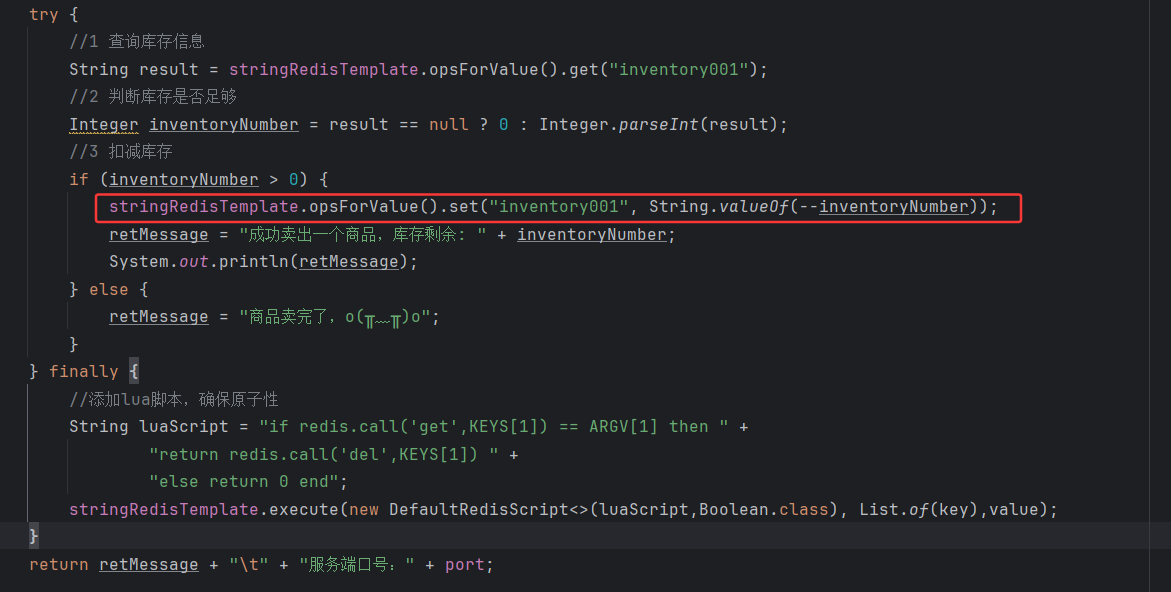
Lua脚本
redis命令过程分析
cmd127.0.0.1:6379> EXISTS lock (integer) 0 127.0.0.1:6379> HSET lock 1a2b3c 1 (integer) 1 127.0.0.1:6379> HINCRBY lock 1a2b3c 1 (integer) 2 127.0.0.1:6379> HGET lock 1a2b3c "2"加锁Lua脚本lock
先判断redis分布式锁这个key是否存在
exists key
返回0说明不存在,hset新建当前线程属于自己的锁 uuid:threadId

返回1说明已经有锁,需进一步判断是不是当前线程自己的
- hexists key uuid:threadID
- 返回0说明不是自己的
- 返回1说明是自己的锁,自增1次表示重入
- hexists key uuid:threadID
上述设计修改为Lua脚本
v1
cmdif redis.call('exists','key') == 0 then redis.call('hset','key','uuid:threadid',1) redis.call('expire','key',30) return 1 elseif redis.call('hexists','key','uuid:threadid') == 1 then redis.call('hincrby','key','uuid:threadid',1) redis.call('expire','key',30) return 1 else return 0 end相同部分是否可以替换处理???
hincrby命令可否替代hset命令
v2
cmdif redis.call('exists','key') == 0 or redis.call('hexists','key','uuid:threadid') == 1 then redis.call('hincrby','key','uuid:threadid',1) redis.call('expire','key',30) return 1 else return 0 endv3
key KEYS[1] lock value ARGV[1] 2f586ae740a94736894ab9d51880ed9d:1 过期时间值 ARGV[2] 30 秒 cmdif redis.call('exists',KEYS[1]) == 0 or redis.call('hexists',KEYS[1],ARGV[1]) == 1 then redis.call('hincrby',KEYS[1],ARGV[1],1) redis.call('expire',KEYS[1],ARGV[2]) return 1 else return 0 end
解锁Lua脚本unlock
设计思路:有锁且还是自己的锁
hexists key uuid:threadID
- 返回零,说明根本没有锁,程序块返回nil
- 不是零,说明有锁是自己的锁,直接调用
hincrby -1表示每次减个1,解锁一次。直到它变为零表示可以删除该锁key,del锁key
设计脚本
v1
cmdif redis.call('HEXISTS',lock,uuid:threadID) == 0 then return nil elseif redis.call('HINCRBY',lock,uuid:threadID,-1) == 0 then return redis.call('del',lock) else return 0 endv2
cmdif redis.call('HEXISTS',KEYS[1],ARGV[1]) == 0 then return nil elseif redis.call('HINCRBY',KEYS[1],ARGV[1],-1) == 0 then return redis.call('del',KEYS[1]) else return 0 end
第七次改造(确保可重入性和原子性)
RedisDistributedLock
package com.lazy.locks;
import cn.hutool.core.util.IdUtil;
import org.springframework.data.redis.core.StringRedisTemplate;
import org.springframework.data.redis.core.script.DefaultRedisScript;
import java.util.Arrays;
import java.util.concurrent.TimeUnit;
import java.util.concurrent.locks.Condition;
import java.util.concurrent.locks.Lock;
public class RedisDistributedLock implements Lock
{
private StringRedisTemplate stringRedisTemplate;
private String lockName;//KEYS[1]
private String uuidValue;//ARGV[1]
private long expireTime;//ARGV[2]
public RedisDistributedLock(StringRedisTemplate stringRedisTemplate, String lockName){
this.stringRedisTemplate = stringRedisTemplate;
this.lockName = lockName;
this.uuidValue = IdUtil.simpleUUID()+":"+Thread.currentThread().getId();//UUID:ThreadID
this.expireTime = 30L;
}
@Override
public void lock(){
tryLock();
}
@Override
public boolean tryLock(){
try {tryLock(-1L,TimeUnit.SECONDS);} catch (InterruptedException e) {e.printStackTrace();}
return false;
}
/**
* 干活的,实现加锁功能,实现这一个干活的就OK,全盘通用
* @param time
* @param unit
* @return
* @throws InterruptedException
*/
@Override
public boolean tryLock(long time, TimeUnit unit) throws InterruptedException{
if(time != -1L){
this.expireTime = unit.toSeconds(time);
}
String script =
"if redis.call('exists',KEYS[1]) == 0 or redis.call('hexists',KEYS[1],ARGV[1]) == 1 then " +
"redis.call('hincrby',KEYS[1],ARGV[1],1) " +
"redis.call('expire',KEYS[1],ARGV[2]) " +
"return 1 " +
"else " +
"return 0 " +
"end";
System.out.println("script: "+script);
System.out.println("lockName: "+lockName);
System.out.println("uuidValue: "+uuidValue);
System.out.println("expireTime: "+expireTime);
while (Boolean.FALSE.equals(stringRedisTemplate.execute(new DefaultRedisScript<>(script, Boolean.class), Arrays.asList(lockName), uuidValue, String.valueOf(expireTime)))) {
TimeUnit.MILLISECONDS.sleep(50);
}
return true;
}
/**
*干活的,实现解锁功能
*/
@Override
public void unlock()
{
String script =
"if redis.call('HEXISTS',KEYS[1],ARGV[1]) == 0 then " +
" return nil " +
"elseif redis.call('HINCRBY',KEYS[1],ARGV[1],-1) == 0 then " +
" return redis.call('del',KEYS[1]) " +
"else " +
" return 0 " +
"end";
// nil = false 1 = true 0 = false
System.out.println("lockName: "+lockName);
System.out.println("uuidValue: "+uuidValue);
System.out.println("expireTime: "+expireTime);
Long flag = stringRedisTemplate.execute(new DefaultRedisScript<>(script, Long.class), Arrays.asList(lockName),uuidValue,String.valueOf(expireTime));
if(flag == null)
{
throw new RuntimeException("This lock doesn't EXIST");
}
}
//===下面的redis分布式锁暂时用不到=======================================
//===下面的redis分布式锁暂时用不到=======================================
//===下面的redis分布式锁暂时用不到=======================================
@Override
public void lockInterruptibly() throws InterruptedException
{
}
@Override
public Condition newCondition()
{
return null;
}
}service
package com.lazy.service;
import cn.hutool.core.util.IdUtil;
import com.lazy.locks.RedisDistributedLock;
import jakarta.annotation.Resource;
import org.springframework.beans.factory.annotation.Value;
import org.springframework.data.redis.core.StringRedisTemplate;
import org.springframework.data.redis.core.script.DefaultRedisScript;
import org.springframework.stereotype.Service;
import java.util.List;
import java.util.concurrent.locks.Lock;
@Service
public class InventoryService {
@Resource
private StringRedisTemplate stringRedisTemplate;
@Value("${server.port}")
private String port;
private final Lock lock = new RedisDistributedLock(stringRedisTemplate,"lock");
public String sale()
{
String retMessage = "";
lock.lock();
try
{
//1 查询库存信息
String result = stringRedisTemplate.opsForValue().get("inventory001");
//2 判断库存是否足够
Integer inventoryNumber = result == null ? 0 : Integer.parseInt(result);
//3 扣减库存
if(inventoryNumber > 0) {
stringRedisTemplate.opsForValue().set("inventory001",String.valueOf(--inventoryNumber));
retMessage = "成功卖出一个商品,库存剩余: "+inventoryNumber;
System.out.println(retMessage);
}else{
retMessage = "商品卖完了,o(╥﹏╥)o";
}
}finally {
lock.unlock();
}
return retMessage+"服务端口号:"+port;
}
}
为了有更好的兼容性我们引入了工程设计模式
DistributedLockFactory
package com.lazy.factory;
import com.lazy.locks.RedisDistributedLock;
import jakarta.annotation.Resource;
import org.springframework.data.redis.core.StringRedisTemplate;
import org.springframework.stereotype.Component;
import java.util.concurrent.locks.Lock;
@Component
public class DistributedFactory {
@Resource
private StringRedisTemplate stringRedisTemplate;
private String lockName;
public Lock getDistributedLock(String lockType) {
if (lockType == null) return null;
if (lockType.equalsIgnoreCase("redis")){
this.lockName = "redisLock";
return new RedisDistributedLock(stringRedisTemplate,lockName);
}else if (lockType.equalsIgnoreCase("mysql")){
//TODO mysql版本的分布式锁实现
return null;
}else if(lockType.equalsIgnoreCase("zookeeper")){
//TODO zookeeper版本的分布式锁实现
return null;
}
return null;
}
}service
package com.lazy.service;
import com.lazy.factory.DistributedFactory;
import jakarta.annotation.Resource;
import org.springframework.beans.factory.annotation.Value;
import org.springframework.data.redis.core.StringRedisTemplate;
import org.springframework.stereotype.Service;
import java.util.concurrent.locks.Lock;
@Service
public class InventoryService {
@Resource
private StringRedisTemplate stringRedisTemplate;
@Value("${server.port}")
private String port;
@Resource
private DistributedFactory distributedFactory;
public String sale()
{
Lock redisLock = distributedFactory.getDistributedLock("redis");
String retMessage = "";
redisLock.lock();
try
{
//1 查询库存信息
String result = stringRedisTemplate.opsForValue().get("inventory001");
//2 判断库存是否足够
Integer inventoryNumber = result == null ? 0 : Integer.parseInt(result);
//3 扣减库存
if(inventoryNumber > 0) {
stringRedisTemplate.opsForValue().set("inventory001",String.valueOf(--inventoryNumber));
retMessage = "成功卖出一个商品,QD库存剩余: "+inventoryNumber;
System.out.println(retMessage);
}else{
retMessage = "商品卖完了,o(╥﹏╥)o";
}
}finally {
redisLock.unlock();
}
return retMessage+"服务端口号:"+port;
}
}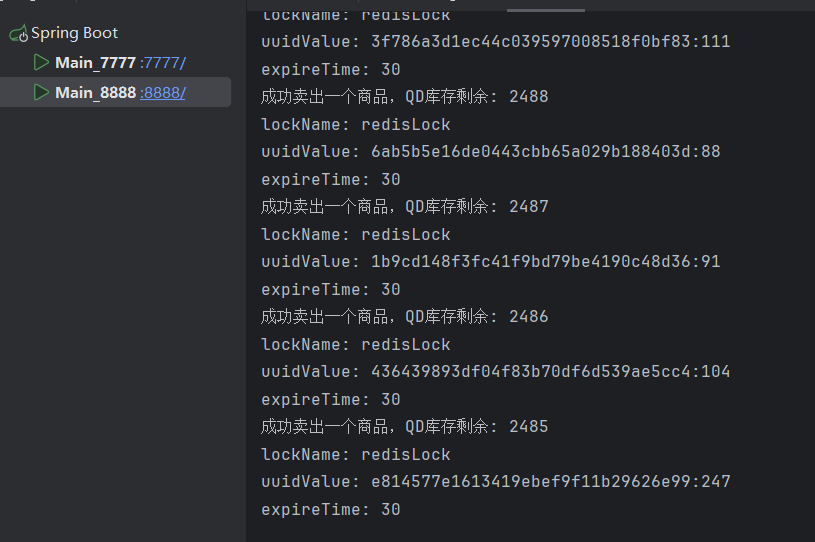
看着好像没问题
可重入测试重点
我们在service增加一个方法试试
package com.lazy.service;
import com.lazy.factory.DistributedFactory;
import jakarta.annotation.Resource;
import org.springframework.beans.factory.annotation.Value;
import org.springframework.data.redis.core.StringRedisTemplate;
import org.springframework.stereotype.Service;
import java.util.concurrent.locks.Lock;
@Service
public class InventoryService {
@Resource
private StringRedisTemplate stringRedisTemplate;
@Value("${server.port}")
private String port;
@Resource
private DistributedFactory distributedFactory;
public String sale()
{
Lock redisLock = distributedFactory.getDistributedLock("redis");
String retMessage = "";
redisLock.lock();
try
{
//1 查询库存信息
String result = stringRedisTemplate.opsForValue().get("inventory001");
//2 判断库存是否足够
Integer inventoryNumber = result == null ? 0 : Integer.parseInt(result);
//3 扣减库存
if(inventoryNumber > 0) {
stringRedisTemplate.opsForValue().set("inventory001",String.valueOf(--inventoryNumber));
retMessage = "成功卖出一个商品,QD库存剩余: "+inventoryNumber;
testLock();
System.out.println(retMessage);
}else{
retMessage = "商品卖完了,o(╥﹏╥)o";
}
}finally {
redisLock.unlock();
}
return retMessage+"服务端口号:"+port;
}
public void testLock() {
Lock redisLock = distributedFactory.getDistributedLock("redis");
redisLock.lock();
try{
System.out.println("测试可重入性方法");
}finally {
redisLock.unlock();
}
}
}启动测试试试
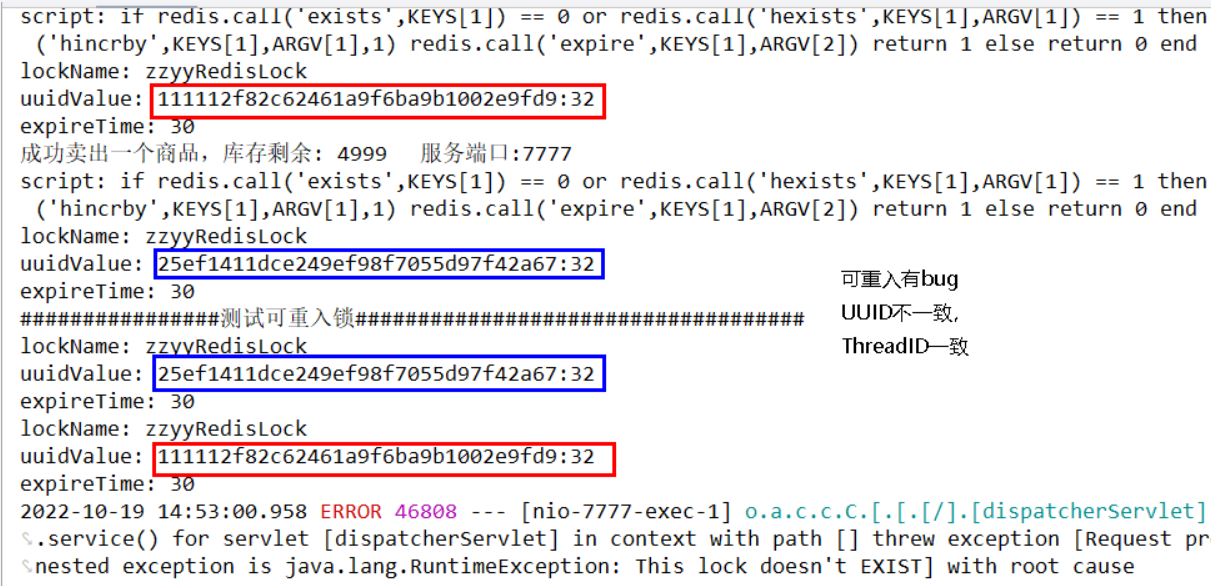
DistributedLockFactory
package com.lazy.factory;
import cn.hutool.core.util.IdUtil;
import com.lazy.locks.RedisDistributedLock;
import org.springframework.beans.factory.annotation.Autowired;
import org.springframework.data.redis.core.StringRedisTemplate;
import org.springframework.stereotype.Component;
import java.util.concurrent.locks.Lock;
@Component
public class DistributedLockFactory
{
@Autowired
private StringRedisTemplate stringRedisTemplate;
private String lockName;
private String uuidValue;
public DistributedLockFactory()
{
this.uuidValue = IdUtil.simpleUUID();//UUID
}
public Lock getDistributedLock(String lockType)
{
if(lockType == null) return null;
if(lockType.equalsIgnoreCase("REDIS")){
lockName = "zzyyRedisLock";
return new RedisDistributedLock(stringRedisTemplate,lockName,uuidValue);
} else if(lockType.equalsIgnoreCase("ZOOKEEPER")){
//TODO zookeeper版本的分布式锁实现
return null;
} else if(lockType.equalsIgnoreCase("MYSQL")){
//TODO mysql版本的分布式锁实现
return null;
}
return null;
}
}RedisDistributedLock
package com.lazy.locks;
import org.springframework.data.redis.core.StringRedisTemplate;
import org.springframework.data.redis.core.script.DefaultRedisScript;
import java.util.Arrays;
import java.util.concurrent.TimeUnit;
import java.util.concurrent.locks.Condition;
import java.util.concurrent.locks.Lock;
public class RedisDistributedLock implements Lock
{
private StringRedisTemplate stringRedisTemplate;
private String lockName;
private String uuidValue;
private long expireTime;
public RedisDistributedLock(StringRedisTemplate stringRedisTemplate, String lockName,String uuidValue)
{
this.stringRedisTemplate = stringRedisTemplate;
this.lockName = lockName;
this.uuidValue = uuidValue+":"+Thread.currentThread().getId();
this.expireTime = 30L;
}
@Override
public void lock()
{
this.tryLock();
}
@Override
public boolean tryLock()
{
try
{
return this.tryLock(-1L,TimeUnit.SECONDS);
} catch (InterruptedException e) {
e.printStackTrace();
}
return false;
}
@Override
public boolean tryLock(long time, TimeUnit unit) throws InterruptedException
{
if(time != -1L)
{
expireTime = unit.toSeconds(time);
}
String script =
"if redis.call('exists',KEYS[1]) == 0 or redis.call('hexists',KEYS[1],ARGV[1]) == 1 then " +
"redis.call('hincrby',KEYS[1],ARGV[1],1) " +
"redis.call('expire',KEYS[1],ARGV[2]) " +
"return 1 " +
"else " +
"return 0 " +
"end";
System.out.println("lockName: "+lockName+"\t"+"uuidValue: "+uuidValue);
while (!stringRedisTemplate.execute(new DefaultRedisScript<>(script, Boolean.class), Arrays.asList(lockName), uuidValue, String.valueOf(expireTime)))
{
try { TimeUnit.MILLISECONDS.sleep(60); } catch (InterruptedException e) { e.printStackTrace(); }
}
return true;
}
@Override
public void unlock()
{
String script =
"if redis.call('HEXISTS',KEYS[1],ARGV[1]) == 0 then " +
"return nil " +
"elseif redis.call('HINCRBY',KEYS[1],ARGV[1],-1) == 0 then " +
"return redis.call('del',KEYS[1]) " +
"else " +
"return 0 " +
"end";
System.out.println("lockName: "+lockName+"\t"+"uuidValue: "+uuidValue);
Long flag = stringRedisTemplate.execute(new DefaultRedisScript<>(script, Long.class), Arrays.asList(lockName), uuidValue, String.valueOf(expireTime));
if(flag == null)
{
throw new RuntimeException("没有这个锁,HEXISTS查询无");
}
}
//=========================================================
@Override
public void lockInterruptibly() throws InterruptedException
{
}
@Override
public Condition newCondition()
{
return null;
}
}测试通过!
第八次改造(添加自动续期)
确保redisLock过期时间大于业务执行时间的问题,在第一次改造上修改
service
package com.lazy.service;
import com.lazy.factory.DistributedLockFactory;
import jakarta.annotation.Resource;
import org.springframework.beans.factory.annotation.Value;
import org.springframework.data.redis.core.StringRedisTemplate;
import org.springframework.stereotype.Service;
import java.util.concurrent.TimeUnit;
import java.util.concurrent.locks.Lock;
@Service
public class InventoryService {
@Resource
private StringRedisTemplate stringRedisTemplate;
@Value("${server.port}")
private String port;
@Resource
private DistributedLockFactory distributedFactory;
public String sale()
{
Lock redisLock = distributedFactory.getDistributedLock("redis");
String retMessage = "";
redisLock.lock();
try
{
//1 查询库存信息
String result = stringRedisTemplate.opsForValue().get("inventory001");
//2 判断库存是否足够
Integer inventoryNumber = result == null ? 0 : Integer.parseInt(result);
//3 扣减库存
if(inventoryNumber > 0) {
stringRedisTemplate.opsForValue().set("inventory001",String.valueOf(--inventoryNumber));
retMessage = "成功卖出一个商品,QD库存剩余: "+inventoryNumber;
//暂停120秒
try {
TimeUnit.SECONDS.sleep(120);
} catch (InterruptedException e) {
throw new RuntimeException(e);
}
}else{
retMessage = "商品卖完了,o(╥﹏╥)o";
}
}finally {
redisLock.unlock();
}
return retMessage+"服务端口号:"+port;
}
}RedisDistributedLock
package com.lazy.locks;
import org.springframework.data.redis.core.StringRedisTemplate;
import org.springframework.data.redis.core.script.DefaultRedisScript;
import java.util.*;
import java.util.concurrent.TimeUnit;
import java.util.concurrent.locks.Condition;
import java.util.concurrent.locks.Lock;
public class RedisDistributedLock implements Lock {
private final StringRedisTemplate stringRedisTemplate;
private final String lockName;
private final String uuidValue;
private long expireTime;
public RedisDistributedLock(StringRedisTemplate stringRedisTemplate, String lockName, String uuidValue) {
this.stringRedisTemplate = stringRedisTemplate;
this.lockName = lockName;
this.uuidValue = uuidValue + ":" + Thread.currentThread().getId();
this.expireTime = 30L;
}
@Override
public void lock() {
this.tryLock();
}
@Override
public boolean tryLock() {
try {
return this.tryLock(-1L, TimeUnit.SECONDS);
} catch (InterruptedException e) {
e.printStackTrace();
}
return false;
}
@Override
public boolean tryLock(long time, TimeUnit unit) throws InterruptedException {
if (time != -1L) {
expireTime = unit.toSeconds(time);
}
String script =
"if redis.call('exists',KEYS[1]) == 0 or redis.call('hexists',KEYS[1],ARGV[1]) == 1 then " +
"redis.call('hincrby',KEYS[1],ARGV[1],1) " +
"redis.call('expire',KEYS[1],ARGV[2]) " +
"return 1 " +
"else " +
"return 0 " +
"end";
System.out.println("lockName: " + lockName + "\t" + "uuidValue: " + uuidValue);
while (!stringRedisTemplate.execute(new DefaultRedisScript<>(script, Boolean.class), Collections.singletonList(lockName), uuidValue, String.valueOf(expireTime))) {
try {
TimeUnit.MILLISECONDS.sleep(60);
} catch (InterruptedException e) {
e.printStackTrace();
}
}
renewExpire();
return true;
}
@Override
public void unlock() {
String script =
"if redis.call('HEXISTS',KEYS[1],ARGV[1]) == 0 then " +
"return nil " +
"elseif redis.call('HINCRBY',KEYS[1],ARGV[1],-1) == 0 then " +
"return redis.call('del',KEYS[1]) " +
"else " +
"return 0 " +
"end";
System.out.println("lockName: " + lockName + "\t" + "uuidValue: " + uuidValue);
Long flag = stringRedisTemplate.execute(new DefaultRedisScript<>(script, Long.class), Collections.singletonList(lockName), uuidValue, String.valueOf(expireTime));
if (flag == null) {
throw new RuntimeException("没有这个锁,HEXISTS查询无");
}
}
private void renewExpire()
{
String script =
"if redis.call('HEXISTS',KEYS[1],ARGV[1]) == 1 then " +
"return redis.call('expire',KEYS[1],ARGV[2]) " +
"else " +
"return 0 " +
"end";
//定时任务每隔10秒后执行一次
new Timer().schedule(new TimerTask()
{
@Override
public void run()
{
if (Boolean.TRUE.equals(stringRedisTemplate.execute(new DefaultRedisScript<>(script, Boolean.class), Arrays.asList(lockName), uuidValue, String.valueOf(expireTime)))) {
renewExpire();
}
}
},(this.expireTime * 1000)/3);
}
//=========================================================
@Override
public void lockInterruptibly() throws InterruptedException {
}
@Override
public Condition newCondition() {
return null;
}
}效果!
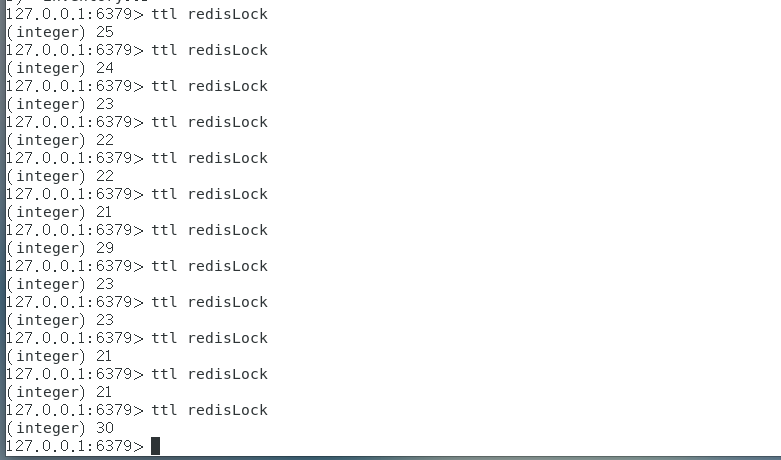
总结
- 第一版:
synchronized单机版OK,上分布式死翘翘 - 第二版:
nginx分布式微服务单机锁不行 - 第三版:取消单机锁改为上
redis分布式锁setnx- 只加了锁,没有释放锁,出异常的话,可能无法释放锁,必须要在代码层面
finally释放锁 - 宕机了,部署了微服务代码层面根本没有走到
finally这块,没办法保证解锁,这个key没有被删除,需要有lockKey的过期时间设定
- 只加了锁,没有释放锁,出异常的话,可能无法释放锁,必须要在代码层面
- 第四版:为
redis的分布式锁key,增加过期时间,此外,还必须要setnx+过期时间必须同一行 - 第五版:必须规定只能删除自己的锁,不能删除别人的锁
- 第六版:
unlock变为lua脚本保证 - 第七版:锁重入,
hset替代setnx+lock变为lua脚本保证 - 第八版:自动续期
